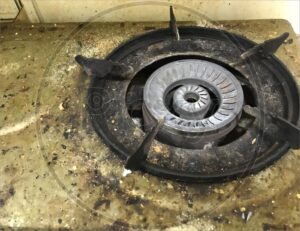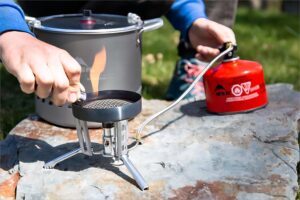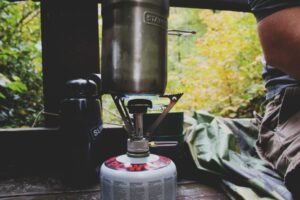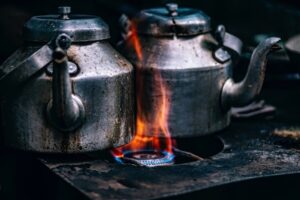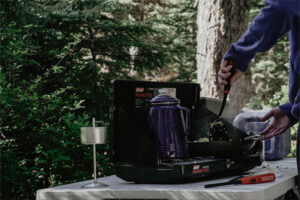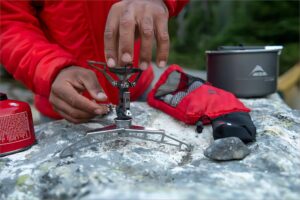
Finally, if you don’t keep your stove away from water and air, it will rust. However, frequent cleaning will keep rust at bay and your stove will last a long time, allowing you to cook endless campground feasts. There is no one-size-fits-all strategy for cleaning your backpacking stove. The best camping stoves come in a variety of designs, shapes, and sizes. Backpackers, wild campers, and thru-hikers appreciate the mobility and weight of an integrated backpacking stove. These machines are quick to clean, but their delicate pieces demand careful attention.
Why a camping stove gets dirty
preparing mess is often unavoidable, especially when preparing greasy, oily foods like bacon and steak, but with the correct preparation, attention, and procedures, possible mess and debris buildup may be prevented.
Cooking food at an excessively high heat is a certain method to causes it to burn and stick to the bottom of your pan. Insufficient oil or fat in the pan can also cause food to stick and burn. The oil forms a nonstick barrier between the pan and the food, limiting direct contact and excessive browning. Overcrowding the pan can also be a concern. Large amounts of food packed into a skillet can cause the temperature to decrease quickly after it is withdrawn from the heat source. As a result, the food releases moisture and, rather than sautéing or browning, tends to steam and stick.
Then there’s failing to mix the contents, using too starchy or sugary ingredients, or just cooking meals for too long. Most pots and pans that interact with burner systems have nonstick coatings, and when these are broken, food tends to cling and burn. How do they become damaged? Typically, this occurs when you use a metal fork or spoon to stir or scrape food off the pan. It may also occur when you clean with an abrasive scrubber.
A clean camping stove works better than a dirty one. Clean stoves provide higher fuel economy and flame control. Furthermore, regular cleanings can assist prevent rust and corrosion. It is critical to clean up after boil-overs or a particularly dirty dinner cooked on the camp stove.
Cleaning on the go
As with anything, cleaning a little at a time generally eliminates the need for more severe cleaning sessions after the filth has accumulated. This is more convenient for vehicle campers, who can clean everything with warm soapy water after each meal. Admittedly, for travelers, this is not an option, therefore it’s always a good idea to clean your stove before storing it after a trip.
What you’ll need to clean your hiking stove
- White vinegar
- Baking soda
- Old toothbrush
- Paper clip / pin
- Olive oil
- Microfiber cloth
- Sandpaper
- Sponge / cloth
A high-pressure hose will remove the most persistent filth, but you may not need to go this far unless you’ve been neglecting your stove for an extended period of time.
How to clean stove pots and pans
To clean pots and pans used for camping stoves, follow these steps:
- To remove burned food from a skillet, gently reheat it with water to dislodge any stubborn bits.
- Turn off the burner and let the pan cool down.
- Remove the pan from the stove and scrape with a soft, non-abrasive cloth. An old toothbrush works great. A light detergent will undoubtedly speed things up here. Make sure to choose one that is biodegradable and not damaging to the environment and avoid washing cookware straight in a river because this might taint the water.
- If you have access to a sink, submerge the pan in warm soapy water to remove filth, then scrub and rinse. Some manufactures recommend heating a 75/25 solution of water and white vinegar in your vessel for a few minutes before cleaning it with a baking soda paste and water.
- Allow ample air-drying time to prevent corrosion. A small application of olive oil might also aid in this respect.
How to clean gas canister stoves
Some stoves have specific cleaning requirements, so confirm them if possible before attempting to clean out a burner yourself.
In most circumstances, trash adhering to a burner will simply burn away. You may also shake a burner upside down to remove any debris that may be within it. Some burner heads can be dipped in water to remove obstinate grime (according to the brand’s instructions). You might also scrape it with a toothbrush, or use a pin or cocktail stick to clear any clogged burner holes.
With larger camp stoves, switch off the system, let it cool, and then wipe clean the hobs and grill area with a moist towel. Some of these stoves will include detachable plates to make cleaning easier.
Mild detergents, a white vinegar and water solution, or baking soda combined into a paste with water all work well for cleaning a burner at home or at a camping. If your camp stove has a lot of oil and filth, you might use a pressure hose as you would at a vehicle wash, but be cautious not to harm any sensitive elements like the spark ignition or burners itself. To keep a burner from rusting, allow proper air drying after washing. You may also apply a thin layer of WD40 or olive oil on it to offer a protective barrier. To remove existing rust, gently scrape it away with an abrasive bad, steel wool, or sandpaper.
How to clean liquid fuel stoves
Before attempting to clean a liquid fuel stove, consult the manufacturer’s instructions, just like you would with a gas burner stove. If there is no instruction provided, follow these procedures.
- Burn off any food stuck to the burner.
- Tap the burner on a hard surface to remove dirt.
- Allow the burner to cool before wiping out any dirt with a moist cloth or an old toothbrush.
- Use WD40 to remove any buildup in the fuel line.
- Air dry the stove to avoid corrosion.

